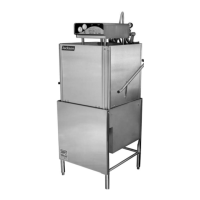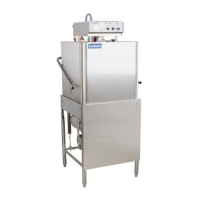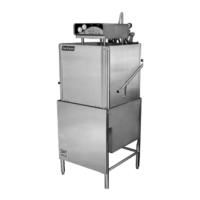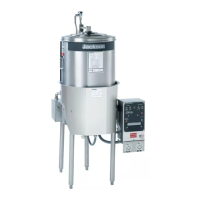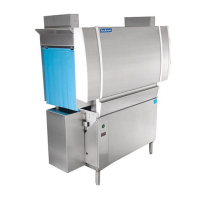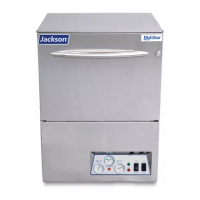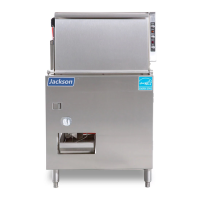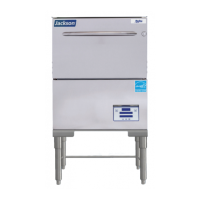PREPARATION: Before proceeding with the start-up of the unit, verify the following:
• The pan strainer and pump suction strainer are clean and in place.
• The overow tube and o-ring are installed.
• The wash and rinse arms are screwed securely into place, rotate freely and that their endcaps are tight.
POWER UP: To energize the unit, turn on the power at the service breaker. The voltage should have been previously
veried as being correct. If not, the voltage must be veried before proceeding.
FILLING THE WASH TUB: For the initial ll, ensure that the cycle selection switch is in the “AUTO” (automatic) position, and
place the power switch in the “ON” position. The unit will ll automatically and run through a rinse cycle. Open the door and
verify that the water level is correct. Hereafter, the water level is controlled by the overow tube. Verify that the drain stopper
is preventing the wash tub water from draining excessively. There may be some slight leakage from the drain hole. Verify that
there are no other leaks on the unit before proceeding any further. The wash tub must be completely lled before operating
the wash pump to prevent damage to the component. Once the wash tub is lled, the unit is ready for operation.
WARE PREPARATION: Proper preparation of ware is essential for the smooth, efcient operation of your dishmachine.
If done properly, you can expect to have fewer re-washes and use substantially less detergent. Any ware placed inside
the machine should have all solid food waste and scraps removed. Pre-rinsing and pre-soaking are required, especially
for silverware and casserole dishes. Place cups and glasses upside down in racks so that they do not hold water during the
cycle. Load plates and saucers in the same direction, with the food surface facing the unload end of the machine.
DAILY MACHINE PREPARATION: Refer to the section entitled “PREPARATION” at the top of this page and follow the
instructions there. Afterwards, check that all of the chemical levels are correct and/or that there is plenty of detergent
available for the expected workload.
WARM-UP CYCLES: For a typical daily start-up, it is recommended to run the machine through 3 cycles to ensure that all
of the cold water is out of the system and to verify that the unit is operating correctly. To cycle the machine, ensure that the
power is on and the tub has lled to the correct level. Lift the door and the cycle light will illuminate. When the light goes
out, close the door. The unit will start, run through a cycle and shut off automatically. Repeat this two more times. The unit
is now ready to proceed with the washing of ware.
WASHING A RACK OF WARE: To wash a rack, open the door completely (beware of hot water dripping from the door)
and slide the rack into the unit. Close the door and the unit will start automatically. Once the cycle is completed, open the
door (again careful of the dripping hot water) and remove the rack of clean ware. Replace with a rack of soiled ware and
close the door. The process will then repeat itself.
OPERATIONAL INSPECTION: Based upon usage, the pan strainer may become clogged with soil and debris as the
workday progresses. Operators should regularly inspect the pan strainer to ensure it has not become clogged. If the
strainer becomes clogged, it will reduce the washing capability of the machine. Instruct operators to clean out the pan
strainer at regular intervals or as required by work load.
15
OPERATING INSTRUCTIONS
INSTALLATION & OPERATION
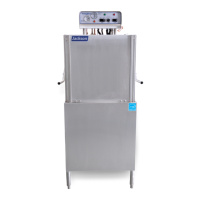
